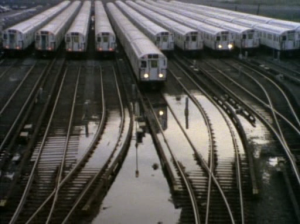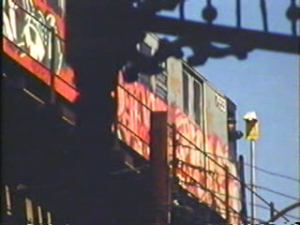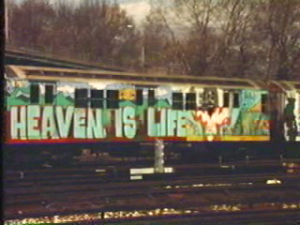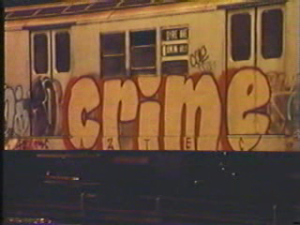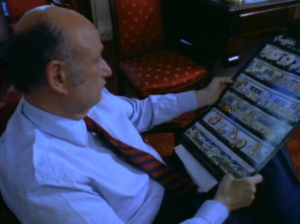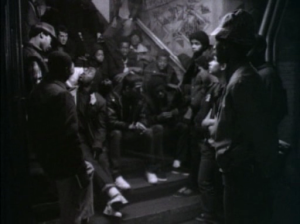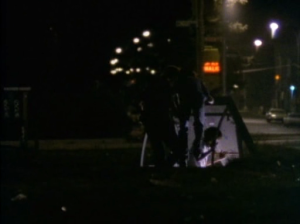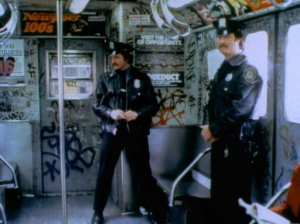Like most people, I had always thought that Style Wars, a documentary film about the hip-hop culture of the early 1980s, first aired on PBS in 1983, was the first to deal with the graffiti scene in New York City. But, also like most people, I hadn’t heard about the movie Stations of the Elevated, released in 1981. Stations of the Elevated is a independent film produced, directed, edited, and photographed by Manfred (Manny) Kirchheimer. Presented by New York’s Museum of Modern Art in 1981, it’s set to the music of legendary New York-based experimental jazz musician Charles Mingus and the sounds of urbana (such as the shrill screech of the trains, horns blaring in traffic, police car sirens wailing, and the indistinguishable sound of crowds) lend itself to the authenticity of the work.
This was perhaps one of the first cohesive attempts to document the phenomenon of graffitied trains in New York City and present it as a cultural phenomenon rather than an act of vandalism. Because there is no commentary, it tries to create a narrative about the urban environment using the elements of the urban visual landscape as brief respites from the monotony of everyday city life. Footage of painted trains rolling along the elevated lines are interspersed with shots of Technicolor billboards and stern brick facades inherent in the corporate landscape, as well as the decaying urban neighborhoods and ghettos that spawned the youngsters who partook in the movement. Stations of the Elevated attempts to give its viewers the experience of living and moving through New York City by relating sights and sounds that are common to its urban setting. The images, experiences, and juxtapositions that tend to stay with viewers at the end of the film are the same that those that would remain at the end of the day walking about town.
Because it was never widely released, Stations of the Elevated is incredibly difficult to get a hold of, especially in its entirety. Despite my extensive combing of the internet, I’ve only been able to download a 27 minute version of it, and if you do as well, I strongly advise that you DO NOT watch it because it’s a total hack job (as in, it features very abrupt cutaways) and a pain to get through because of it. Rather, watch it streaming in five parts starting here. Although I tend to abhor watching streaming movies, especially in parts, Stations of the Elevated is definitely one worth seeing, especially if you want to experience New York City in the early 1980s.
Style Wars was a documentary film co-produced and directed by Tony Silver, and co-produced by Henry Chalfant, who provided the background research as well as photo-documentation throughout the movie. It’s almost as if Tony Silver and Henry Chalfant wanted to expand on the idea of Stations of the Elevated. In actuality, Chalfant had been taking pictures for three years and had probably not known about its development. Rather than presenting assumptions and drawing conclusions about the spawning of a new expressive art out of urban decay, Silver and Chalfant worked to present graffiti as the controversial form of expression that it is, providing viewpoints from all sides, including then New York City Mayor Ed Koch, Head of MTA Richard Ravitch, various MTA personnel, parents, random citizens, conventional artists, art collectors, as well as the graffiti writers and graffiti artists themselves.
Style Wars works to introduce its audience to the entire blossoming hip-hop culture of the early 1980s, not only graffiti. If graffiti was chosen means of written communication, then rap was a new means of verbal communication, and break dancing served as the new means of body language. Style Wars moves seamlessly between these the branches of the hip hop movement, and documents them as a new method of communication developed by the youth population to communicate with each other.
Much like Stations of the Elevated, Style Wars opens in a train yard under the cover of darkness (much like graffiti). Poetically, an elevated train passes under a lone street lamp, first at a distance, then closer, illuminating some indistinguishable markings on the side. However, instead of jazz, Style Wars opens the movie with a Wagner orchestral composition which had been made popular by the movie Excalibur, released only a few years before. This choice is a rather poignant one (that may not be appreciated as much by the film’s younger audience), as the composition was one that could be associated with glorified action and adventure. And admittedly, glory and adventure were the two objects of the graffiti game in the 1980s. Then, in the full light of day, tagged-up trains burst forth into the full and the music cuts to hip hop.
There is no doubt that Style Wars is a well-made film. It is both informative and appealing, both graphically and audibly. It is also exciting, following graffiti writers into underground tunnels and into train yards. The film follows and features interviews and works from graffiti writers and artists such as Iz the Wiz, Seen, Zephyr, Skeme, Mare, Case, Doze, Mean Dez, Duster, Dondi, Min, Case, among others, and perhaps most controversial, Cap (a toy tag bomber). Additionally, Style Wars comments on the importance of knowing the roots of graffiti writing (Taki 183) and predicts the future of the movement and its appeal to the art world. Not only does the film explain the incredibly diametrically opposed philosophies of the government and the graffiti artists and writers, but also the difference of opinions between those who consider themselves graffiti artist and those who write/bomb/tag. This dynamic documentary draws the viewer into the tensions that exist between the differing viewpoints exhibited in the films, creating a plot worthy of any feature length film.
Perhaps among the most poignant of questions the viewer might have once they’ve watched these two awesomely engrossing films is “why did it take so long for the next graffiti/street art documentary to be produced?” Over the next 20 years maybe only half a dozen mainstream feature-length films based loosely on graffiti writers or crews have been made, and it wasn’t until 2005 that appreciation for graffiti and the documentation of the movement was renewed in full force. In fact, in 2005, no less than six graffiti documentaries were released, including Infamy, NEXT: A Primer on Urban Painting, Piece by Piece, Rash: Scratch it and it Spreads, Friendly Fire, and the Stolkholm Subway Stories.
However, it is no coincidence that over a generation had to pass before the retrospective importance of the roots of the graffiti movement, now global, could be realized. Even after numerous government counter-measures attempted to stifle the creative expression of the first generation of graffiti writers out of Northeast America, the movement nevertheless spread throughout America and the rest of the world. Since the 2000s, a new generation of graffiti artists and street artists, inspired by the urban visual landscape of the 1980s (especially that of NYC), have taken up the mantle and are continuing the self-expressive tradition of graffiti in the urban setting, and the importance of the movement is being recognized by the main stream contemporary art world. In fact, Kirchheimer returned to broach the subject of New York City graffiti in his 2007 documentary Spraymasters, which featured Lee Quiñones, Zephyr, Lady Pink, and Futura, who reflect on their own youthful adventures, their development, this new generation of writers and artists, as well as the world-wide interest in the graffiti and street art movement.
An interview with Stations of the Elevated’s Manny Kirchheimmer can be found here and an interview with Style Wars’ Tony Silver and Henry Chalfant can be found here as well as in the extra features of Style Wars. Check out my featured films page for more documentaries and films about graffiti and street art.
